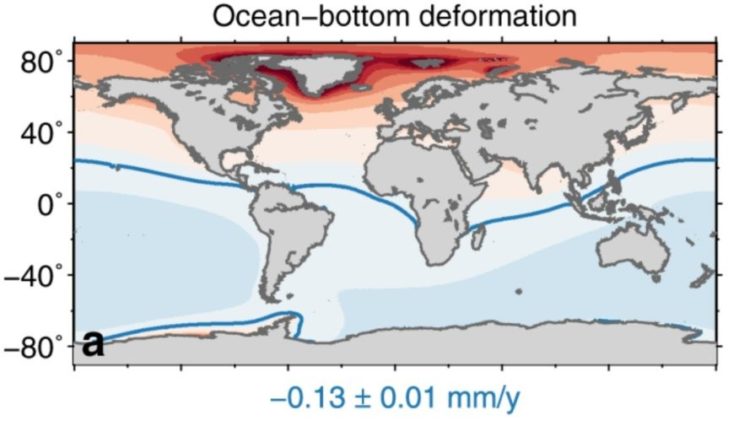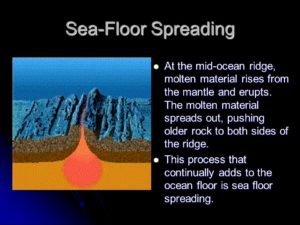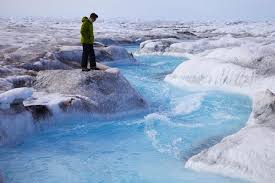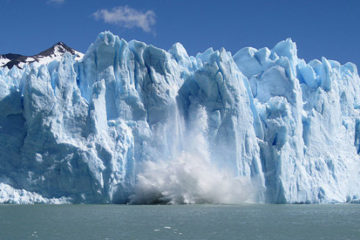Scientists Believe Ocean Floor Is Sinking : A Well Thought Out Scream by James Riordan

Now here’s something I bet you haven’t thought about. Many scientists now believe that the ocean floor is sinking and that’s very bad – as if you didn’t have enough to worry about. Another side effect of global warming is that melting glaciers are adding so much extra water into the world’s oceans that the ocean floor is sinking underneath its increasing weight. Bet you didn’t see that one coming. This deformation of the ocean floor also means that we have miscalculated just how much ocean levels and the coming deformation of the ocean floor are rising and the problem could be far worse than previously believed.
 Decades of measurements and predictions of sea level rise could have underestimated the scale of the problem, experts warn, due to scientists not accounting for the weighty, warping effects of our ever burgeoning oceans. Existing assessments of sea level rise haven’t factored in that as the total ocean mass increases due to melting glaciers and ice sheets, the weight of all that extra water pushes down on the sinking ocean floor, deforming the seabed – and disguising just how much the oceans are truly swelling. Over the past 20 years, ocean basins have sunk an average of 0.004 inches per year. This means that the ocean is 0.08 inches deeper than it was two decades ago. While this small fragment of an inch may not seem much, oceans cover 70 percent of our planet, making the problem bigger than it seems at an initial glance.
Decades of measurements and predictions of sea level rise could have underestimated the scale of the problem, experts warn, due to scientists not accounting for the weighty, warping effects of our ever burgeoning oceans. Existing assessments of sea level rise haven’t factored in that as the total ocean mass increases due to melting glaciers and ice sheets, the weight of all that extra water pushes down on the sinking ocean floor, deforming the seabed – and disguising just how much the oceans are truly swelling. Over the past 20 years, ocean basins have sunk an average of 0.004 inches per year. This means that the ocean is 0.08 inches deeper than it was two decades ago. While this small fragment of an inch may not seem much, oceans cover 70 percent of our planet, making the problem bigger than it seems at an initial glance.
In a study published online in Geophysical Research Levels researchers explain how they used a mathematical equation known as the elastic sea level equation to more accurately measure the ocean floor. This allowed them to see how much the bottom of the ocean floor has changed from 1993 to 2014. While they are not the first scientists to look at the ocean floor, this is the first time that researchers have taken into account how additional water from melted ice may have further stretched the ocean floor. The results show that the ocean is changing in ways that we previously did not realize and is sinking further into the earth’s crust. As a result, scientists have underestimated how much sea levels are rising by as much as 8 percent. The study concludes by emphasizing that future sea level measurement should take ocean floor deformation into account in order to more accurately understand how our oceans are changing.
 “The Earth itself is not a rigid sphere, it’s a deforming ball,” geoscientist Thomas Frederikse from the Delft University of Technology in the Netherlands said. “With climate change, we do not only change temperature.”
“The Earth itself is not a rigid sphere, it’s a deforming ball,” geoscientist Thomas Frederikse from the Delft University of Technology in the Netherlands said. “With climate change, we do not only change temperature.”
The implications, according to Frederikse and his team, is that as the ocean bottom subsides elastically, the actual increasing volume of the ocean – called barystatic sea level rise – is masked from measurements based on satellite observations.
That’s because satellite readings only tell us one side of the story: geocentric sea level rise, as seen from the surface side. “Because satellite altimetry observes sea level in a geocentric reference frame, global mean sea-level estimates derived from altimetry will not observe the increase in ocean volume due to ocean-bottom subsidence, and hence, they may underestimate [global mean sea-level] rise,” the researchers explain in a new paper.
All the water on the planet today is all the water that has ever existed on the planet, but not all water is in its liquid form. Recently, rising temperatures have caused much of the frozen water on the planet’s glaciers to melt and join the ocean as liquid. This mass melting ice rising sea levels, a problem whose consequences we’re already starting to see. The first to notice the repercussions of rising sea levels are those who live in coastal areas. Rising waters mean less land to live on. In addition, more water in the ocean means that ocean storms, such as hurricanes, have the potential to be stronger and more devastating. Small coastal areas won’t be the only ones to disappear due to rising waters and if current estimates are correct, by 2100 the ocean will rise between 11 and 38 inches, a number that could mean that much of the U.S. east coast will be covered in water.
Undersea Vocanoes
To quantify how much the bottom of the ocean is deforming under the extra load of meltwater, the researchers used various estimates of mass loss from glaciers, the Greenland and Antarctic ice sheets, and land water storage, including groundwater depletion and dam retention.
For roughly the last two decades (the period 1993–2014), the team calculates the increase of the total ocean load has pushed the seabed down by about 0.13 mm (0.005 inches) per year, or around 2.5 mm (almost 1 inch) in total for the period.

That might not sound like much, but in some regions the deformation is significantly greater – up to 1 mm (0.04 inches) per year over the Arctic Ocean, and 0.4 mm (0.016 inches) per year in the South Pacific.
Overall, the researchers say purely satellite-derived assessments of sea level rise for the period could have underestimated barystatic sea level rise by as much as 8 percent – which is definitely something we need to think about in the future, especially this hidden variable will only become more significant as the world gets hotter and sea level rise accelerates. “In a future warming climate, the sea-level rise induced by ice sheets will increase, and therefore, the magnitude of the bias due to elastic ocean-bottom deformation will grow,” the team writes. “To increase the accuracy of sea-level estimates, the effect of ocean-bottom deformation should be taken into account, either based on modeled estimates of ocean mass change, as was done in this study, or using more direct observations.”
 So, looking on the bright side, for right now, you can just keep worrying about greenhouse gases and nuclear holocaust.
So, looking on the bright side, for right now, you can just keep worrying about greenhouse gases and nuclear holocaust.
__







No Comment